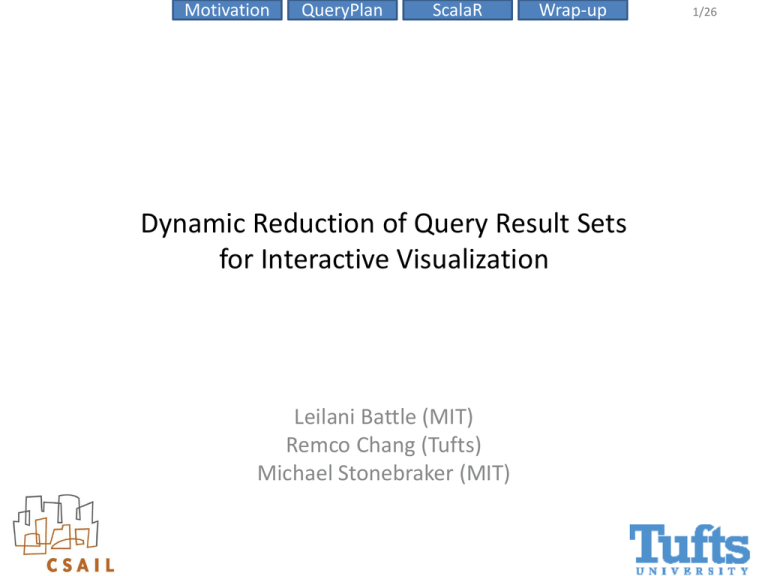BigDataVis
advertisement

Motivation
QueryPlan
ScalaR
Wrap-up
Dynamic Reduction of Query Result Sets
for Interactive Visualization
Leilani Battle (MIT)
Remco Chang (Tufts)
Michael Stonebraker (MIT)
1/26
Motivation
QueryPlan
Context
Visualization System
query
result
Database
ScalaR
Wrap-up
2/26
Motivation
QueryPlan
ScalaR
Wrap-up
3/26
Problems with Most VIS Systems
• Scalability
– Most InfoVis systems assume that memory stay in-core
– Out-of-core systems assume locality and/or structure in
data (e.g. grid).
– Database-driven systems leverage operations specific to
the application (e.g. column-store for business analytics)
• Over-plotting
– Makes visualizations unreadable
– Waste of time/resources
Motivation
QueryPlan
ScalaR
Wrap-up
The Problem We Want to Solve
Visualization on a
Commodity Hardware
Large Data in a
Data Warehouse
4/26
Motivation
QueryPlan
ScalaR
Wrap-up
5/26
Apporach: Trading Accuracy For Speed
• In the Vis community
– Common practice, e.g.
• Based on Data: Elmqvist and Fekete (TVCG, ’10)
• Based on Display: Jerding and Stasko (TVCG, ‘98)
• In the Database community
– Less common, e.g.
• Stratified Sampling: Chaudhuri et al. (TOD, ’07)
• (BlinkDB) Bounded Errors and Response Time: Agarwal et al.
(Eurosys ‘13)
• Online Aggregation: Hellerstein et al. (SIGMOD ‘97), Fisher et
al. (CHI ‘12)
Motivation
QueryPlan
ScalaR
Wrap-up
Our Solution: Resolution Reduction
Visualization System
query
Resolution Reduction Layer
queryplan
query
modified query
queryplan
result
reduced result
Database
6/26
Motivation
QueryPlan
ScalaR
Wrap-up
Our Implementation: ScalaR
• Back-end database: SciDB
– An array-based database for scientific data
• Front-end visualization: javascript + D3
• Middleware:
– Named ScalaR
– Written as a web-server plugin
– “Traps” queries from the front-end and
communicates with the back-end
7/26
Motivation
QueryPlan
ScalaR
Wrap-up
8/26
Query Plan and Query Optimizer
• (Almost) All database systems have a query
compiler
– Responsible for parsing, interpreting, and generating
an efficient execution plan for the query
• Query optimizer
– Responsible for improving query performance based
on (pre-computed) meta data.
– Designed to be super fast
– Continues to be an active area of DB research
Motivation
QueryPlan
ScalaR
Wrap-up
Example Query Plan / Optimizer
• Given a database with two tables:
dept
(dno, floor)
emp (name, age, sal, dno)
• Consider the following SQL query:
select name, floor
from employ, dept
where employ.dno = dept.dno
and employ.sal > 100k
Example taken from “Query Optimization” by Ioannidis, 1997
9/26
Motivation
QueryPlan
Possible Query Plans
ScalaR
Wrap-up
10/26
Motivation
QueryPlan
ScalaR
Wrap-up
Cost of the Query
• For a database with 100,000 employees
(stored across 20,000 page files), the three
query plans can have significantly different
execution time (in 1997):
– T1: <1 sec
– T2: >1 hour
– T3: ~1 day
11/26
Motivation
QueryPlan
ScalaR
Wrap-up
12/26
Query Plan Exposed – SQL EXPLAIN
• The “EXPLAIN” command
– Exposes (some of) the computed results from the
Query Optimization process
– Not in SQL-92
– The results are DBMS-specific
• Usage:
explain select * from myTable;
Motivation
QueryPlan
ScalaR
Wrap-up
13/26
Example EXPLAIN Output from SciDB
• Example SciDB the output of (a query similar to)
Explain SELECT * FROM earthquake
[("[pPlan]:
schema earthquake
<datetime:datetime NULL DEFAULT null,
magnitude:double NULL DEFAULT null,
latitude:double NULL DEFAULT null,
longitude:double NULL DEFAULT null>
[x=1:6381,6381,0,y=1:6543,6543,0]
bound start {1, 1} end {6381, 6543}
density 1 cells 41750883 chunks 1
est_bytes 7.97442e+09
")]
The four attributes in the table
‘earthquake’
Notes that the dimensions of this
array (table) is 6381x6543
This query will touch data
elements from (1, 1) to (6381,
6543), totaling 41,750,833 cells
Estimated size of the returned
data is 7.97442e+09 bytes
(~8GB)
Motivation
QueryPlan
ScalaR
Other Examples
• Oracle 11g Release 1 (11.1)
Wrap-up
14/26
Motivation
Other Examples
• MySQL 5.0
QueryPlan
ScalaR
Wrap-up
15/26
Motivation
QueryPlan
Other Examples
• PostgreSQL 7.3.4
ScalaR
Wrap-up
16/26
Motivation
QueryPlan
ScalaR
Wrap-up
17/26
ScalaR with Query Plan
• The front-end tells ScalaR its desired
resolution
– Can be based on the literal resolution of the
visualization (number of pixels)
– Or desired data size
• Based on the query plan, ScalaR chooses one
of three strategies to reduce results from the
query
Motivation
QueryPlan
ScalaR
Wrap-up
Reduction Strategies in ScalaR
• Aggregation:
– In SciDB, this operation is carried out as
regrid (scale_factorX, scale_factorY)
• Sampling
– In SciDB, uniform sampling is carried out as
bernoulli (query, percentage, randseed)
• Filtering
– Currently, the filtering criteria is user specified
where (clause)
18/26
Motivation
QueryPlan
ScalaR
Wrap-up
Example
• The user launches the visualization, which
shows the overview of the data
– Resulting in launching the query:
select latitude, longitude from quake
– As shown earlier, this results in over 41 million
values
19/26
Motivation
QueryPlan
ScalaR
Wrap-up
Example
• Based on the user’s resolution, using
Aggregation, this query is modified as:
select avg(latitude), avg(longitude)
from (select latitude, longitude
from quake)
regrid 32, 33
• Using Sampling, this query looks like:
select latitude, longitude
from bernoulli (select latitude, longitude
from quake), 0.327, 1)
20/26
Motivation
QueryPlan
ScalaR
Wrap-up
Strategies for Real Time DB Visualization
21/26
Motivation
Using SciDB
QueryPlan
ScalaR
Wrap-up
22/26
Motivation
QueryPlan
Performance Results
• Dataset: NASA MODIS
• Size: 2.7 Billion data
points
• Storage: 209GB in
database (85GB
compressed), across
673,380 SciDB chunks
• Baseline:
select * from ndsil
ScalaR
Wrap-up
23/26
Motivation
QueryPlan
ScalaR
Wrap-up
24/26
Benefits of ScalaR
• Flexible!
– Works on all visualizations and (almost) all databases
• As long as the database has an EXPLAIN function
• No Learning Curve!
– Developers can just write regular SQL queries, and
– do not have to be aware of the architecture
• Adaptive!
– Easily swap in a different DBMS engine, different visualization,
or different rules / abilities in ScalaR.
• Efficient!
– The reduction strategy can be based on perceptual constraint
(resolution) or data constraint (size)
Motivation
QueryPlan
ScalaR
Wrap-up
25/26
Discussion
• Efficient operations are still DB dependent
– SciDB: good for array-based scientific data
• Efficient aggregation (e.g., “regrid”)
– OLAP: good for structured multidimensional data
• Efficient orientation (e.g., “pivot”)
– Column-Store: good for business analytics
• Efficient attribute computation (e.g., “avg (column1)”)
– Tuples (NoSQL), Associative (network), etc., Multi-value DB
(non-1NF, no-joins), etc.
• How does ScalaR know which operation to use?
– One possible way is to “train” ScalaR first – give it a set of
query logs (workload) to test the efficiency of different
strategies
Motivation
QueryPlan
ScalaR
Wrap-up
Thank you!!
Questions?
Leilani Battle (MIT)
Remco Chang (Tufts)
Mike Stonebraker (MIT)
leibatt@mit.edu
remco@cs.tufts.edu
stonebraker@csail.mit.edu
26/26





